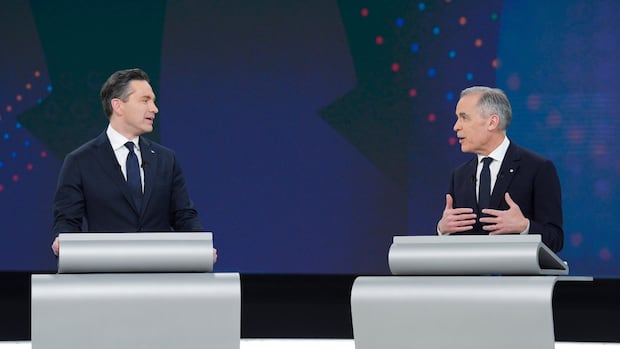Carney & Poilievre: Two Sides of the Same Coin? Exploring Divergent Threats to Canada's Future
Editor’s Note: The contrasting economic philosophies of Mark Carney and Pierre Poilievre are generating significant debate in Canada. This article analyzes their differing approaches and their potential impact on the nation's future.
1. Why This Matters:
Canada stands at a crossroads. Economic uncertainty, climate change, and geopolitical instability demand decisive leadership. The starkly different visions offered by former Bank of Canada Governor Mark Carney and Conservative Party leader Pierre Poilievre represent two potential paths for the country. Understanding their approaches—and their potential consequences—is crucial for Canadian citizens. This article will explore their key economic policies, analyzing their strengths, weaknesses, and potential impact on various sectors of Canadian society. We will examine their stances on issues such as inflation, climate action, and energy policy, ultimately assessing whether their differences represent truly divergent threats, or simply two sides of the same coin – both presenting challenges to Canada's future prosperity.
2. Key Takeaways:
| Feature | Mark Carney | Pierre Poilievre |
|---|---|---|
| Economic Focus | Sustainable growth, climate action, inclusive capitalism | Lower taxes, reduced regulation, energy independence |
| Inflation Approach | Gradual tightening, focus on long-term stability | Immediate cuts to spending, focus on supply-side solutions |
| Climate Policy | Aggressive emissions reduction targets, carbon pricing | Increased oil and gas production, reduced environmental regulations |
| Energy Policy | Transition to renewable energy, investment in green technology | Expansion of fossil fuel industry, support for pipelines |
3. Main Content
3.1 Carney & Poilievre: A Clash of Economic Philosophies
The debate between Carney and Poilievre highlights a fundamental disagreement about Canada's economic future. Carney advocates for a sustainable, inclusive model that prioritizes long-term stability and environmental responsibility. He emphasizes the need for significant investment in green technologies and a gradual transition away from fossil fuels. This approach, while potentially beneficial for the environment and future generations, may involve short-term economic costs and potential job displacement in traditional sectors.
Poilievre, on the other hand, champions a more free-market approach, emphasizing deregulation, tax cuts, and increased energy production. He argues that focusing on economic growth and reducing the burden on businesses will create jobs and boost the economy. This approach, however, raises concerns about environmental sustainability and potential exacerbations of existing economic inequalities.
3.2 Interactive Elements: The Debate's Impact
The differing visions of Carney and Poilievre have significant implications for various sectors. The energy sector, for example, faces a stark choice between a gradual transition to renewable energy (Carney's vision) or a continued expansion of fossil fuels (Poilievre's vision). Similarly, the financial sector will be affected by differing approaches to regulation and monetary policy. The debate also raises questions about social safety nets and the distribution of wealth in Canada.
3.3 Advanced Insights: Beyond the Headlines
A deeper analysis reveals that both Carney and Poilievre's approaches present significant challenges. Carney's emphasis on sustainability requires substantial investment and a willingness to accept potential short-term economic pain. Poilievre's focus on rapid economic growth risks exacerbating existing inequalities and potentially harming the environment. Neither approach is without significant risks and potential downsides. Experts suggest a more nuanced, balanced approach that integrates elements of both philosophies may be necessary to navigate Canada’s complex economic challenges.
4. People Also Ask (NLP-Friendly Answers)
Q1: What is the main difference between Carney and Poilievre's economic philosophies? A: Carney advocates for sustainable, inclusive growth with a focus on climate action, while Poilievre prioritizes lower taxes, deregulation, and increased energy production.
Q2: Why is this debate important for Canada? A: It shapes the direction of Canada's economic and environmental policies, impacting jobs, investment, and the country's long-term prosperity.
Q3: How will these differing views impact everyday Canadians? A: The chosen path will affect job opportunities, cost of living, environmental quality, and the overall standard of living.
Q4: What are the potential risks of each approach? A: Carney's approach risks slower economic growth in the short term, while Poilievre's risks environmental damage and increased inequality.
Q5: Can a middle ground be found? A: Many experts suggest a balanced approach is needed, combining sustainable growth with responsible resource management and inclusive economic policies.
5. Practical Tips for Understanding the Debate:
- Research both Carney and Poilievre's policy proposals in detail.
- Compare their stances on key issues like climate change and energy.
- Analyze the potential economic and social consequences of each approach.
- Consider the long-term implications of each vision for Canada.
- Engage in informed discussions with others about the different perspectives.
6. Summary:
The contrasting visions of Mark Carney and Pierre Poilievre represent significant challenges and opportunities for Canada. Understanding their differing approaches, their potential consequences, and the need for a balanced, nuanced strategy is crucial for navigating the country's complex economic and environmental future.
7. Call to Action:
Ready to delve deeper into this crucial debate? Share this article and contribute to the conversation on Canada's future!

